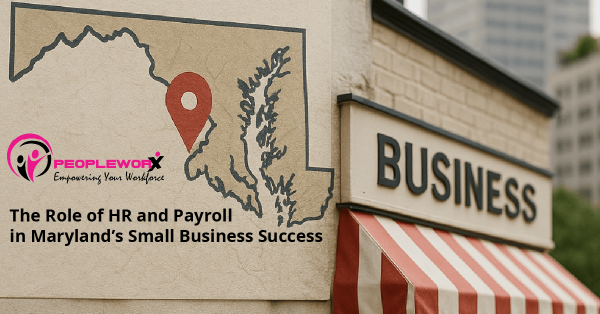From Frederick to the Eastern Shore, Maryland’s small businesses are navigating a year of mixed signals: growth headlines on one hand, labor frictions and cost pressures on the other. Here’s what really matters for owners and HR leaders across the DMV metro area, plus practical ways to turn today’s policy shifts into payroll, hiring, and compliance wins.
Content
- “Boom or mirage?” What the data (and Main Street) are saying
- Hiring is steady, but still hard
- New state procurement rules = new routes to revenue
- Southern Maryland’s “tools for small business” moment
- Where Maryland SMBs are winning with a people-first HR model
- Your Maryland HR/Payload Checklist for Q4
- Why PeopleWorX for the DMV
1) “Boom or mirage?” What the data (and Main Street) are saying
Local coverage has spotlighted a split-screen economy: the State touts rising business formation and marquee wins, while many owners still feel squeezed by labor costs and demand volatility. WBFF’s reporting captures that tension, noting both the surge in new business applications and skepticism from operators who don’t equate an application with a staffed, revenue-producing establishment. WBFF
What it means for SMB HR: Separate the signal (actual establishment births and jobs) from the noise (applications). Track hires, turnover, and hours at the location level. Align your staffing and payroll forecasts to establishment-level reality, then adjust comp and scheduling monthly, not annually.
2) Hiring is steady, but still hard
NFIB’s latest Maryland snapshot shows 32% of small employers reporting jobs they can’t fill, unchanged month over month and still above historic norms. Skilled roles remain the toughest (28% of owners have openings there). Translation: hiring hasn’t worsened, but the “last mile” of finding qualified people is still a drag on growth. NFIB – NFIB Small Business Association
People-first playbook:
- Use job costing and labor allocations to justify targeted pay bumps for hard-to-fill roles; document ROI by tying labor to project margin.
- Tighten cycle time from offer to first paycheck—fast, paper-light onboarding keeps candidates from ghosting.
- Capture shift differentials and bonuses inside payroll rules so managers can use incentives confidently without creating compliance risk.

3) New state procurement rules = new routes to revenue
Effective October 1, 2025, Maryland’s Procurement Reform Act modernizes how the state buys, aiming to speed timelines, widen access, and make it easier for small and veteran-owned firms to compete. For SMBs that sell to the public sector (directly or via primes), this is a quietly meaningful tailwind. WBFF
What to do now (even if you’ve never sold to the state):
- Get bid-ready on the people side. Clean I-9s, active e-Verify, current certifications, and role-based training records. These are table stakes in proposals and audits.
- Stand up labor-tracking by contract/task. If you win, you’ll need to prove who worked, when, at what rate, without scrambling at invoice time.
- Activate a Veteran-Owned/Small-Business narrative. The Act elevates inclusive procurement. Make sure your credentials, headcount, and Maryland footprint are easy for buyers to verify. WBFF

4) Southern Maryland’s “tools for small business” moment
Regional convenings in Southern Maryland have centered on practical tools, capital access, training, and market access—for smaller employers. The through-line: owners want fewer theory sessions and more “do-this-now” checklists that translate into payroll accuracy, compliant hiring, and steady pipeline.
Actionable next steps you can implement this quarter:
- Workforce readiness: Map every role to required credentials and due dates; automate reminders and training completion logs.
- Multi-county hiring: Standardize onboarding packets for MD + adjoining states (DC/VA/PA) to prevent tax-withholding and wage-rule errors as you scale across the DMV.
- Cash-flow guardrails: Tie overtime and differential triggers to manager approvals; give finance weekly variance reports tied to projects or programs.
5) Where Maryland SMBs are winning with a people-first HR model
The “technology + dedicated expert” approach isn’t just nicer service; it’s operational leverage. Two Maryland organizations illustrate how people-centered HR turns uncertainty into consistent execution:
- WFX Fire, Lock & Security (Westminster, MD & Hanover, PA)
Challenge: multi-state compliance and prevailing wage.
Result: automated MD/PA tax setup, specialized wage handling, and a named payroll rep who resolves issues quickly, freeing the team to focus on jobs and margins. - Community Living, Inc. (Frederick, MD)
Challenge: complex nonprofit scheduling, monthly state audits, ongoing training.
Result: time tracked by client ID, GL-integrated payroll for clean audits, and LMS-driven credential tracking—plus direct access to a dedicated account team for fast problem-solving.
These aren’t edge cases, they’re blueprints for Maryland employers who need to stay compliant, invoice cleanly (including on state work), and keep teams engaged while hiring remains tight.
Your Maryland HR/Payload Checklist for Q4
- Audit your job architecture (titles, rates, differentials) against current hiring friction and project mix.
- Lock down documentation (I-9, W-4, MW507, e-Verify, training records).
- Enable contract-level labor tracking ahead of any procurement opportunities. Maryland News
- Shorten the offer-to-pay window with electronic onboarding and same-cycle payroll enrollment. NFIB – NFIB Small Business Association
- Name a single HR/payroll escalation path so managers aren’t stuck in ticket queues during crunch time.
Why PeopleWorX for the DMV
Maryland SMBs don’t need more dashboards, they need a partner. PeopleWorX pairs modern payroll and HR tech with a dedicated representative who knows your business, your counties, and your compliance profile, so you can scale across MD/DC/VA without tripping over tax, time, or training.






